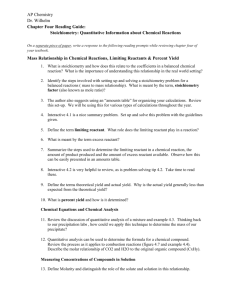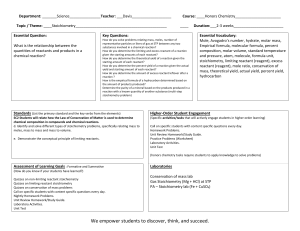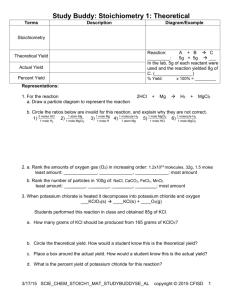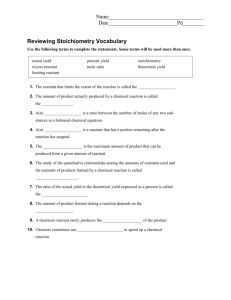Stoichiometry lecture outline
advertisement
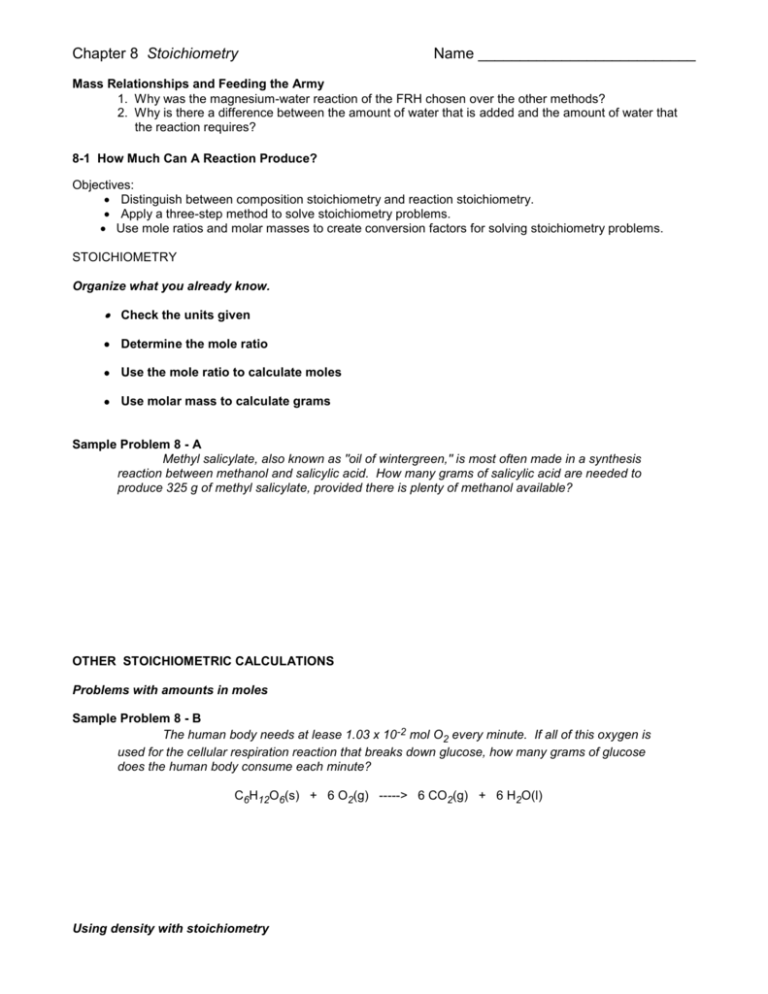
Chapter 8 Stoichiometry Name __________________________ Mass Relationships and Feeding the Army 1. Why was the magnesium-water reaction of the FRH chosen over the other methods? 2. Why is there a difference between the amount of water that is added and the amount of water that the reaction requires? 8-1 How Much Can A Reaction Produce? Objectives: Distinguish between composition stoichiometry and reaction stoichiometry. Apply a three-step method to solve stoichiometry problems. Use mole ratios and molar masses to create conversion factors for solving stoichiometry problems. STOICHIOMETRY Organize what you already know. Check the units given Determine the mole ratio Use the mole ratio to calculate moles Use molar mass to calculate grams Sample Problem 8 - A Methyl salicylate, also known as "oil of wintergreen," is most often made in a synthesis reaction between methanol and salicylic acid. How many grams of salicylic acid are needed to produce 325 g of methyl salicylate, provided there is plenty of methanol available? OTHER STOICHIOMETRIC CALCULATIONS Problems with amounts in moles Sample Problem 8 - B The human body needs at lease 1.03 x 10-2 mol O2 every minute. If all of this oxygen is used for the cellular respiration reaction that breaks down glucose, how many grams of glucose does the human body consume each minute? C6H12O6(s) + 6 O2(g) -----> 6 CO2(g) + 6 H2O(l) Using density with stoichiometry Sample Problem 8 - C In the space shuttle, the CO2 that the crew exhales is removed from the air by a reaction within canisters of lithium hydroxide. On average, each astronaut exhales about 20.0 mol of CO 2 daily. What volume of water will be produced when this amount of CO2 reacts with an excess of LiOH? (Hint: the density of water is about 1.oo g/mL.) CO2(g) + 2 LiOH(s) ------> Li2CO3(aq) + H2O Calculating the number of atoms or formula units 8-2 How Much Does A Reaction Really Produce? Objectives: Distinguish between a limiting reactant and an excess reactant. Identify the limiting reactant in a problem, and calculate the theoretical yield. Distinguish between theoretical yield and actual yield. Given the actual yield and the quantity of the limiting reactant, calculate the percent yield. Use percent yield to calculate the actual yield. LEFTOVER REACTANTS Reactants combine in specific whole-number ratios Excess reactant - reactant that will not be used ut in a reaction that goes to completion Limiting reactant - reactant that is consumed first in a reaction that goes to completion. Determining the limiting reactant Sample Problem 8 - D Carbon monoxide can be combined with hydrogen to produce methanol, CH 3OH. Methanol is used as an industrial solvent, as a reactant in synthesis, and as a clean-burning fuel for some racing cars. If you had 152.5 kg CO and 24.50 kg H2, how many kilograms of CH3OH could be produced? Cost is a factor in selecting the limiting reactant. INCOMPLETE REACTIONS Measuring what a chemical reaction actually produces Theoretical yield - calculated maximum amount of product possible from a given amount of reactant. Actual yield - measured amount of product actually produced from a given amount of reactant. Percent yield is a way to describe a reaction effiency Percent yield - ratio of actual yield to theoretical yield, multiplied by 100 actual yield percent yield = theoretical yield x 100 Practice Problem 8 - E One step in making para-aminobenzoic acid, PABA, an ingredient in some suntan lotions, involves replacing one of the hydrogen atoms in a toluene molecule with an -NO2 group, directly opposite the -CH3 group. Calculate the percent yield if 550 g of toluene added to an excess of nitric acid provides 305 g of the nitrotoluene product. Percent yield figures can be used to predict actual yield. Practice Problem 8 - F A more efficient way to prepare the molecule that was used to produce PABA for suntan lotions involves a slightly different starting material, known as isopropylbenzene. This reaction usually has a 91.2% yield. How many grams of the product, para-nitro-isopropylbenzene, can you expect if 775 g of isopropylbenzene react with an excess of nitric acid? 8-3 How Can Stoichiometry Be Used? Objectives: Relate volume calculations in stoichiometry to the inflation of automobile safety air bags. Use the concept of limiting reactants to explain why changing fuel-air ratios affects engine performance. Use percent yield to compare the effiency of pollution-control mechanisms in cars. Air-bag design depends on stoichiometric precision. 2 NaN3(s) -----> 2 Na(s) + 3 N2(g) 6 Na(s) + Fe2O3(s) -----> 3 Na2O(s) + 2 Fe Practice Problem 8 - G Assume that 65.1 L of N2 gas are needed to inflate an air bag to the proper size. How many grams of NaN3 must be included in the gas generant to generate this amount of N 2? (Hint: the density of N2 gas at this temperature is about 0.916 g/L). Practice: 1. How much Fe2O3 must be added to the gas generant for this amount of NaN3? Engine efficiency depends on the reactant proportions gasoline + air -----> carbon dioxide + water + energy 2 C8H18(g) + 25 O2(g) -----> 16 CO2(g) + 18 H2O(g) + 10,900 kJ Sample Problem 8 - H How many liters of air must react with 1.000 L of isooctane in order for combustion to occur completely? At 20 degrees Celcius, the density of isooctane is 0.6916 g/mL, and the density of oxygen is 1.331 g/L. (Hint: remember to use the percentage of oxygen in air.) Car designers use stoichiometry to control pollution ultraviolet radiation NO2(g) -------------------------------> NO(g) + O(g) O2(g) + O(g) ----------> O3(g)



